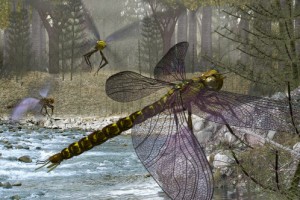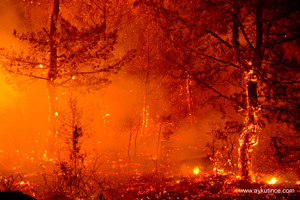How big can an insect get? One night a few years back, I opened the door onto our patio to let the dogs out and an enormous flying, buzzing thing came through the door. When I say ‘enormous,’ I simply mean it was big enough to startle both dogs enough that they ran upstairs, causing me to grab for a flyswatter as it flitted and hummed around the room. I lost sight of it and suddenly all was silent. Our cat had sprung, and the bug was quickly dispatched. We dubbed it ‘Mothra’ and added it to our dog lore. After all, where were our Border Collie and Sheltie when we needed them? Peering down at us from the upstairs landing, while the cat did the dirty work.

‘Mothra’ was probably no more than an inch long — he was noisier than he was big. But there was a time when ‘enormous’ really meant something. Meganeura is a genus of insects dating to the Carboniferous period when creatures related to our own familiar dragonfly boasted wingspans of two feet or more. Meganeura monyi is considered one of the largest flying insects ever, a creature that fed not only on other insects but also on small amphibians, and could probably have made off with a present-era cat. Sufficient reason to keep the screen door closed.
Image: An artist’s conception of Meganeura monyi. Good luck if one of these gets into your living room. Credit: Surface Vision.
Some people believe that gigantism in some animal groups was the result of higher levels of oxygen in the atmosphere, the consequence of the colonization of land by plants. And some would argue that higher amounts of oxygen allowed vertebrates to colonize land surfaces. Today we’ve got an oxygen level of 21 percent, but we know the levels have varied greatly in the past 400 million years and have declined steadily since the middle of the Cretaceous.
Studying this has been tricky because we use geochemical models to estimate the level of atmospheric oxygen, and various models produce differing results. But new work just published in Nature Geoscience now shows that the amount of charcoal preserved in ancient peat bogs provides a measure of how much oxygen was available in the past and may be the best way to measure the phenomenon. The variation is striking. Charcoal found in coal has remained at concentrations between 4-8 percent over the past 50 million years, indicating oxygen levels similar to today. But some earlier periods show a charcoal percentage as high as 70 percent.
That latter figure implies, according to Andrew Scott (Royal Holloway University of London) that high levels of atmospheric oxygen would have been available to spread frequent, large fires in both the Carboniferous and Permian periods, from 320-250 million years ago, and the Middle Cretaceous, approximately 100 million years ago. Says Scott: “It is interesting that these were times of major change in the evolution of vegetation on land with the evolution and spread of new plant groups, the conifers in the late Carboniferous and flowering plants in the Cretaceous.”

We may be dealing with a self-perpetuating mechanism: Frequent, hot fires resulting from high levels of atmospheric oxygen could have caused more erosion and thus greater burial of organic carbon, which creates a cycle keeping oxygen levels high. The burial of carbon was particularly high during the late Paleozoic, which is marked by the accumulation of huge coal deposits. Ian Glasspool (Field Museum, Chicago) notes the relationship between oxygen and flammability:
“Atmospheric oxygen concentration is strongly related to flammability. At levels below 15% wildfires could not have spread. However, at levels significantly above 25% even wet plants could have burned, while at levels around 30 to 35%, as have been proposed for the Late Paleozoic, wildfires would have been frequent and catastrophic”.
The mystery then becomes why oxygen levels stabilized in the last 50 million years. We have much to learn about the mechanisms promoting and regulating life on our own planet. How useful it will ultimately be to be able to compare what we find on other planets with our own history. The discovery of biomarkers in the atmosphere of an extraterrestrial world would be met with celebration, but it will also remind us how little we know about how those biomarkers change over time and the effect those changes have on indigenous life.
The paper is Glasspool & Scott, “Phanerozoic concentrations of atmospheric oxygen reconstructed from sedimentary charcoal,” Nature Geoscience, published online 1 August, 2010 (abstract).



This argument: “More O2 = more charcoal” puzzles me, because as I understand, charcoal is produced when wood (bones or other stuff) is burned in the absence of sufficient O2 (http://en.wikipedia.org/wiki/Charcoal). Do the authors mean that charcoal was produced in subterranean organic deposits when a fire passed over it?
On a tangent: as a (former) evolutionary biologist, I have occasionally speculated (over alcohol) about how plants would evolve under conditions of high O2 (and the likelihood of wildfires). My main conclusion was that plants with life histories resistant to fire would come to predominate. (In modern habitats subject to fire, plants have several such adaptations, including fire-resistant bark and cones that only release their seeds when scorched; subterranean growing centres that are protected by soil from the heat; and the “seed bank”, that is only released to sprout when fire removes the overgrowth. Probably many more adaptations exist.)
The argument “Higher O2 = more frequent wild fires = less O2 therefore 20 %” seems unsupportable: the next question is “Why 20%?”
O2 was found in the bubbles of the ancient amber (60 – 120 million y. o.). Concentration of O2 in antediluvian times was so high as 32-35% . Such conclusion was made by Russian scientists which studied the ancient amber.
“At a meeting of the Geological Society of America in Boston, Landis and co-workers reported that the amber bubbles show a sharp drop in the atmosphere’s oxygen concentration at the end of the Cretaceous period, from a high of 35 percent down to 29 percent.”
http://findarticles.com/p/articles/mi_m1200/is_n19_v144/ai_14651399/
http://www.sciencedirect.com/science?_ob=ArticleURL&_udi=B6VF0-48B09VC-4T&_user=10&_coverDate=12%2F31%2F1991&_rdoc=1&_fmt=high&_orig=search&_sort=d&_docanchor=&view=c&_acct=C000050221&_version=1&_urlVersion=0&_userid=10&md5=1aad1534afb3d1a8ff83d963dd5c0271
http://www.nytimes.com/1987/12/09/us/scientists-challenge-finding-of-oxygen-in-ancient-amber.html
Based on faint memories of college biology, IIRC insects have a very inefficient respiratory system so today’s lower oxygen levels may indeed be limiting their size. Another factor may be competition from other types of animals that wasn’t present 300 million years ago.